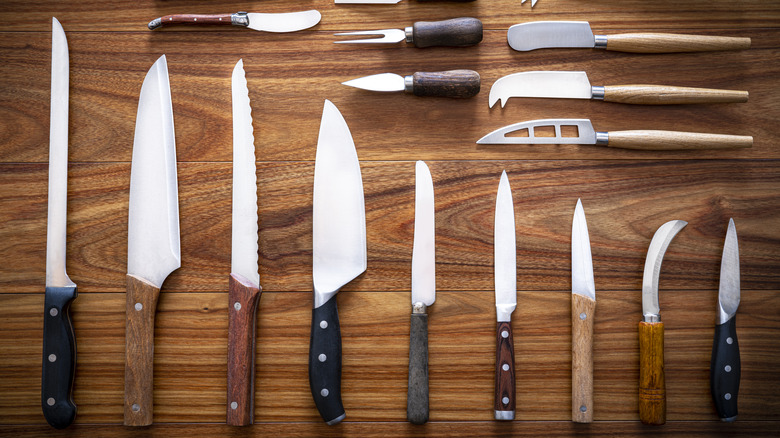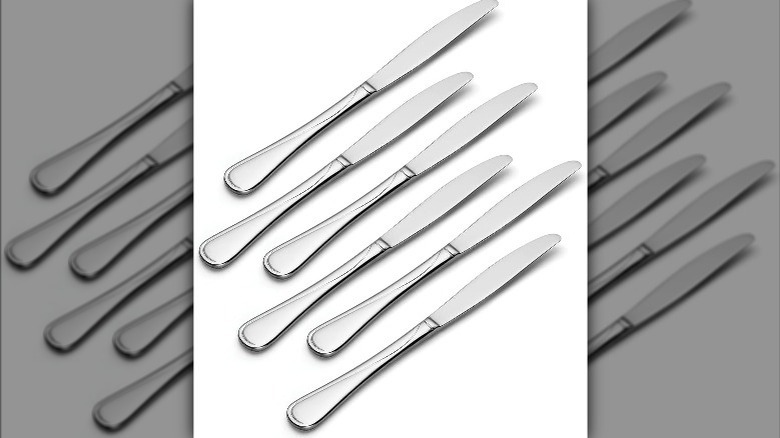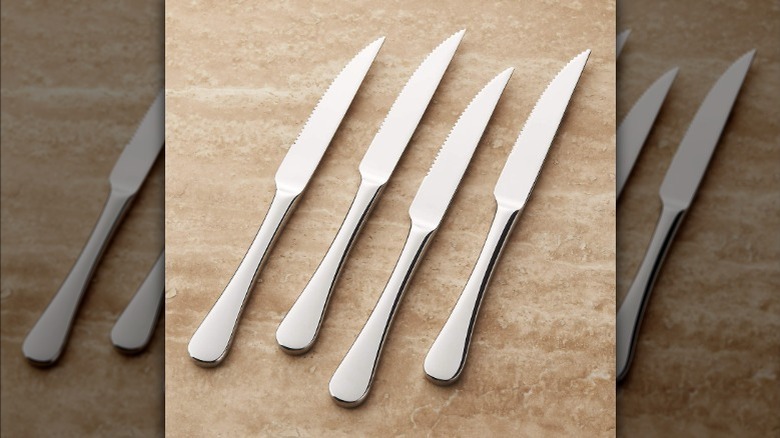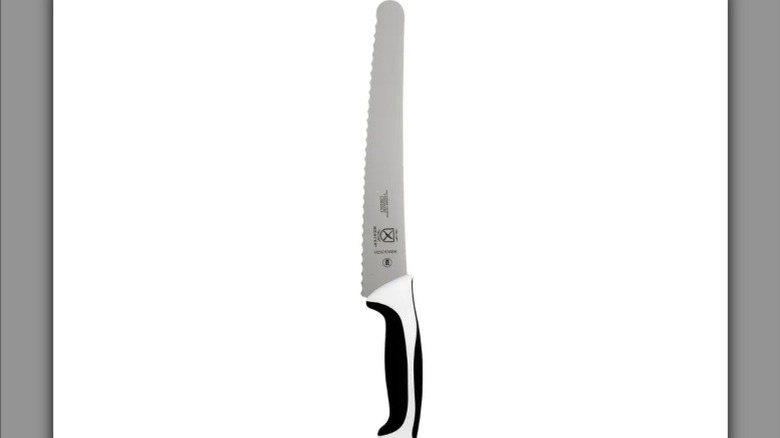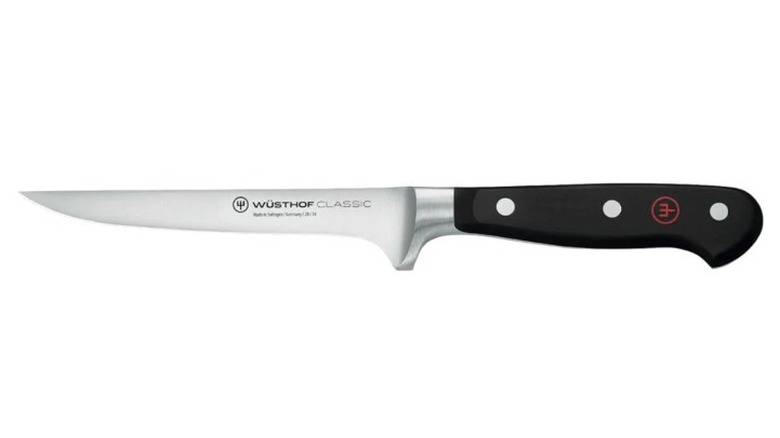The Ultimate Guide To Knives: When And Why We Use Each Type
We may receive a commission on purchases made from links.
The other day, I was in my kitchen cooking a meal and I needed to chop an onion. Indiscriminately, I picked up my go-to knife and started chopping away. Midway through, I glanced up at my knife block. I began to take a mental inventory of what knives I had and how often I used them. The truth is, despite having several differently shaped and sized knives, I predominately use only two of them.
So, I decided to look into my different knives, how they should be used, and whether there were knives I didn't have that I should get. Since knife work is such a crucial part of cooking, I thought I'd share my discoveries to help others in their preparations, ensuring both safer and higher-quality cooking. Here's what I discovered.
Table knives
If you've bought or received a silverware set, you have table knives. Housed in the silverware drawer with matching forks and spoons, these basic knives are used with a traditional place setting. With mild cutting power and some serration, they are run-of-the-mill instruments used for getting food to mouth after it's been placed on the table.
Purchase the Oneida flight everyday flatware dinner knives for $14.99 on Amazon.
Butter knives
These oddly shaped blades aren't used for cutting. More of a hard spatula than a knife, these non-essential, but nice-to-have tools are great for different kinds of butter, jams, cream cheese, and anything else of similar consistency/softness. They perform better than table knives for such things because they often have shorter blades — perfect for spreading butter without destroying your bread.
Purchase the Crysto stainless steel butter knife set for $4.94 on Amazon.
Steak knives
I love steak. As a result, I know the regular-old table knife described above isn't going to cut it (pun alert). When you need something a bit more powerful to handle your table-side meat-cutting needs, you use a steak knife. Often serrated but not always, steak knives ensure an easier cut so as not to frustrate you while meat-eating. They're perfect for steaks, chops, and chicken breasts.
Purchase the Caesna Mirror steak knives for $44.95 for four at Crate & Barrel.
Carving knives
Around the holidays, turkeys, hams, and roasts are ultra-popular. In order to properly serve meal-sized portions to your guests, you'll need to slice up the meat. To do this well requires an implementation up to the challenge of slicing even, thin, long pieces. Your best bet is to use a slicing or carving knife with a carving fork. Their long, non-serrated blades are perfect for churning out perfect slices of turkey or pork roast.
Purchase the Hammer Stahl carving knife and fork set for $89.95 from Heritage Steel.
Bread knives
There aren't many carbs better than fresh-baked bread, and there aren't many more unappetizing carbs as a smooshed piece. With a hard outer crust and warm, soft inside, you'll need a knife that can handle its versatile cutting needs. Bread knives appear similar in size and shape to carving knives, but they differ in their serrated edges. This serration allows you to easily cut through the crust without smooshing the loaf, thus preserving the airy quality and volume of a perfect slice.
Purchase the Mercer bread knife for $18.28 on Action Sales.
Chef's knives
This knife is typically pretty large — around an eight-inch blade. If you see a knife in your set that looks like it could be used in a slasher film, that's likely your chef's knife. These blades probably get a ton of use. They're great for chopping and mincing. They can even slice wonderfully if you don't have a carving knife handy — particularly for something like a pork or beef tenderloin.
Purchase the Shun chef's knife for $169.95 from Crate & Barrel.
Utility knives
As the name suggests, these are pure utility. This versatile knife can slice and chop quite well. Admittedly, this is the one that gets the most use in my house. It's not as large as the chef's knife, and might not have the same balance and rock for chopping or dicing that a chef's knife has, but it's great for slicing up a small roast, cutting up a cucumber, or halving that monster sub you just made.
Purchase this utility knife for $65 from Misen.
Boning knives
If you ever need to do some prep work involving the removal of meat from a bone (think deboning a ribeye steak prior to cooking it for fajitas), I highly recommend using a boning knife. These shorter, thinner, curved blades help you get the appropriate control, angles and cuts a larger blade won't.
Purchase the Wüsthof forged boning knife for $115 from Charlie's Fixtures.
Paring knives
Another tool for detail work is the paring knife. Shaped like a utility knife, but with a shorter blade, these are great for peeling a zucchini or slicing smaller items like berries, cherries, and grapes.
Purchase the forged pairing knife for $39.95 from All-Clad.
Meat cleavers
These massive, heavy, semi-scary-looking things are surprisingly versatile. If you're dealing with large, bone-in cuts of meat you need to cut down before cooking, the meat cleaver will be your best friend. These are great for vertically halving ribs, or cutting up a bone-in prime rib, for instance. Your other knives aren't made for cutting through large bones, and using them could be unsafe and damaging to the blades. Additionally, because of their weight and varied non-cutting edges, meat cleavers work as great makeshift meat tenderizers too.
Purchase the Dry Ager cleaver for $249 from Wine Cooler Planet.
Tomato knives
I hate slicing tomatoes. Their skin is so tough. The same can be said for peaches and plums. Using any of the knives above could mash the fruit on the way to an unappetizing slice. Luckily, there are knives up to the task. These oddly shaped blades are given away by their twin-horned-looking tips. But this shape, along with their serrated edges, makes cutting through the tough skin and soft fruit a breeze.
Purchase the tomato slicer for $15.60 from Rada.
Kitchen shears/scissors
I always wondered what the deal was with the kitchen shears. I just used them to cut open packaging and things like that. However, if you work with dough, especially thinner dough, for pizzas and pies, kitchen shears come in handy. Additionally, cutting up basil, or something like it, is a snap with these.
Purchase the pull-apart kitchen shears for $25 from Wüsthof.
